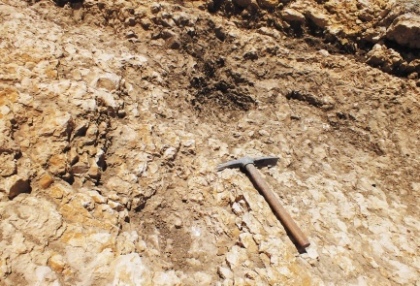Has archeological evidence been found of the Tabernacle?
During the conquest of Canaan, the Tent of Worship or the Tabernacle was set up in a hill town named Shiloh. It was here that Joshua, successor to Moses, completed the apportioning of the Land of Promise. The Tabernacle, the portable Temple built according to the exact design specifications given by God to Moses was to remain in Shiloh for over 3 centuries. It would stay here for most if not all of the era of the Judges (356 years). According to Talmudic sources, it was in place in Shiloh for a total of 369 years.
Inside the Tabernacles innermost room called the Holy of Holies, was the most sacred object in Israelite worship, the Ark of the Covenant, which represented the presence of Jehovah God. This is why God spoke of Shiloh as the place, “...where I first caused my name to reside.” (Jeremiah 7:12) For the over 3 centuries the Ark of the Covenant dwelled there, Shiloh and not Jerusalem, was the center of worship for the Israelites.
While still a young boy, Samuel was brought to Shiloh to serve at the Tabernacle by his parents. By this point the Tabernacle had been situated there for centuries and the original courtyard curtain-walls seem to have been replaced with stone walls. One of the young Samuel’s duties was to open the doors to the courtyard every morning.
The Ark of the Covenant’s time in Shiloh came to an end during the time Samuel served as prophet and judge in Israel. During that time the fighting men of Israel went out to meet their mortal enemy the Philistines in battle and to their surprise, they lost. Rather than inquire of Jehovah as to the reasons for their loss, they reasoned that what they needed on the front lines was the Ark of the Covenant. Evidently they viewed the Ark as a magical talisman that would guarantee their victory. So they removed the Ark and to the astonishment of the nation, they not only lost again they also lost the sacred Ark to the Philistines.
After seven months, the Ark was recovered, but it never returned to Shiloh again. God had, “forsook the tabernacle of Shiloh“. (Psalms 78:60) It seems that around this time the city of Shiloh was also devastated by its enemies. In time the Ark found a home again in Jerusalem in the Temple built by King Solomon. The prophet Jeremiah warned the people of Jerusalem against falsely trusting in the presence of the Temple to protect when they had abandoned their God. “…go now to my place in Shiloh, where I first caused my name to reside, and see what I did to it because of the badness of my people Israel.” (Jeremiah 7:12)
Today the site of ancient Shiloh has been positively identified with Khirbet Seilun, an archeological mound located precisely where the Bible indicates Shiloh was situated, “…in Shiloh, which is north of Bethel and east of the highway that goes up from Bethel to Shechem and south of Lebonah.” (Judges 21:19)
The site is a large hill surrounded by even higher hills. Archeological work has been done there since the 1920s. Since the Tabernacle was a tent, it should not be expected that any trace of it will ever be found. However archeologists have discovered large public store rooms along with large ovens which some scholars believe may have been used in connection with the Tent of Worship. In addition piles of bones and broken pottery have been discovered that may give evidence of sacrificial meals, like the Communion meal.
As to where the Tabernacle was located, an intriguing discovery was made. Some assumed that the top of the hill was the most logical location for the Tabernacle. Today, the top of the hill is exposed bedrock, leaving no trace of what was there previously. Other scholars dispute that location, pointing out that the Tabernacle compound would have taken more space then the top of the hill offers. Exodus 38: 9 & 13 specifies that the courtyard was 50 (likely standard) cubits by 100 cubits (44.5 by 22.2 metres or 146 by 73 feet), a significant space.
To the north of the summit of the hill, is a large, flat rectangular surface that is cleared to the bedrock (see top picture). It is evident that this space has been artificially hewn, or at least enhanced to its current size and shape. Today this feature is called the “Tabernacle Plateau”. It is large enough to have accommodated the Tabernacle and its courtyard. Further the platform is aligned east-west just as Exodus 38:13 indicates the Tabernacle should be. It seems reasonable to conclude as have many Bible scholars (though not all) that this space was the most likely location of the Tabernacle complex in Shiloh.
In 2013 various Israeli newspapers reported that archeologists working on the Tabernacle Plateau had discovered a number of holes carved into the ground.

Tabernacle Post Holes?
These holes it is suggested once held posts in place that may have supported the Tabernacle itself. Although their findings were to be showcased at a conference in a nearby Israeli settlement, I have seen no further reports. The post holes may indeed have been associated with the Tabernacle but going on the limited information that came out at that time, I have to say, it seems like wishful thinking.
Photo Credit:
Photo by “House of Peace” {{PD}} Source: Wikimedia Commons
Tabernacle Post Holes? Photo Credit: Tel Shiloh

Nice research. Thanks. It is difficult for Archeology to be definitive, because they never know what they missed, or how close they are to the actual sites. And their interpretations are influenced by so many human factors. But, it is always good to find evidence that reinforces our faith in God’s Word.